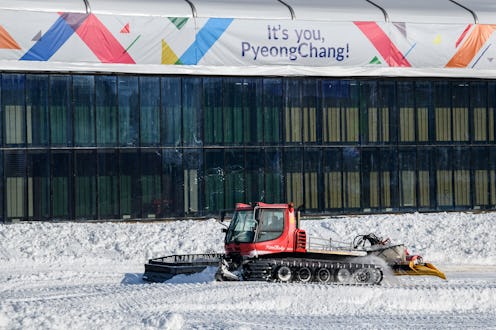News
All The Clever Strategies For Not Freezing During The Opening Ceremony

As Olympic athletes gather in PyeongChang to compete in the Winter Games, the guests in attendance will soon face a physical challenge of their own: Surviving the opening ceremony. The city plunged into sub-zero temperatures earlier in the week, and the stadium in which the games are taking place doesn't have a roof. Naturally, this has many attendees wondering if the the Olympics opening ceremony stadium will be heated.
That depends on exactly how you define "heated." The open-air PyeongChang Olympic Stadium doesn't have a central heating system, so in that sense — arguably, the most important sense — the opening ceremony won't be heated.
But the organizers of the games are well aware that the opening ceremony could quickly become a nightmare without some sort of heating accommodations, given that on the Tuesday before the games, temperatures in the city hit -4 degrees Fahrenheit. Thankfully, it's not expected to be quite as frigid during the opening ceremony, but organizers have nonetheless taken a couple of steps to protect athletes and attendees from the cold.
For one, a windscreen will be erected around the stadium to cut down on the wind chill factor. There will also be 40 portable gas heaters scattered around the stadium and 27 "heating respite" areas during the opening ceremony. Finally, attendees will be handed what Channel News Asia unironically refers to as a "survival kit," consisting of a blanket and several heating pads, when they enter the roofless stadium.
Still, you can't help but question whether these measures will be sufficient, given that in November, seven people got hypothermia while attending a pop concert at the same stadium. That's why some teams are taking matters into their own hands — or, in some cases, their own suits.
The U.S. Olympics Committee announced in January that Team USA will be given special parkas with a "wearable heat" system installed to prevent them from freezing during the opening ceremony. Designed in partnership with Ralph Lauren, the parkas' interiors are lined with conductive ink, which in turn is connected to a battery pack with several heat settings and 11 hours' worth of power.
"It's the most technologically advanced jacket ever produced," David Lauren, Ralph's son and the company's chief innovation officer, told USA Today. "There have been heatable blankets for kids before but they have wires. This is a fabric with ink that heats up — it's weightless, it's conductive and it's immediate." He added that the athletes will be able to control the parka's jacket wirelessly using their cell phones.
Meanwhile, some athletes without the luxury of heated parkas may skip out on the opening ceremonies entirely.
Peter Wardell, chief de mission for the New Zealand team, said Monday that "quite a few [New Zealand athletes] may decide they don't want to march, particularly those competing really soon after." Pita Taufatofua, a Tongan cross-country skier, told ABC News that he won't attend the opening ceremony shirtless, as he did during the 2016 Summer Games in Rio, explaining that "I want to still be alive for my race."
Although the stadium will have some heating accommodations, there's one big catch: Spectators may have to wait in line for several hours before entering the stadium itself. That's why International Olympic Committee spokesman Mark Adams is advising guests to "wrap up and prepare properly" before arriving at the opening ceremony.
"I don't think the cold will be a problem while I'm jumping because it's just for a short time," Japanese ski jumper Noriaki Kasai told Channel News Asia. "The scariest bit will be the opening ceremony. I'll have to stick heat patches all over my body for that."